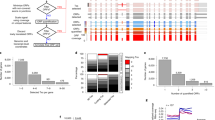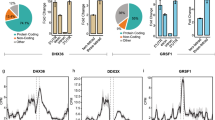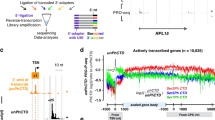Abstract
Human Staufen1 (Stau1) is a double-stranded RNA (dsRNA)-binding protein implicated in multiple post-transcriptional gene-regulatory processes. Here we combined RNA immunoprecipitation in tandem (RIPiT) with RNase footprinting, formaldehyde cross-linking, sonication-mediated RNA fragmentation and deep sequencing to map Staufen1-binding sites transcriptome wide. We find that Stau1 binds complex secondary structures containing multiple short helices, many of which are formed by inverted Alu elements in annotated 3′ untranslated regions (UTRs) or in 'strongly distal' 3′ UTRs. Stau1 also interacts with actively translating ribosomes and with mRNA coding sequences (CDSs) and 3′ UTRs in proportion to their GC content and propensity to form internal secondary structure. On mRNAs with high CDS GC content, higher Stau1 levels lead to greater ribosome densities, thus suggesting a general role for Stau1 in modulating translation elongation through structured CDS regions. Our results also indicate that Stau1 regulates translation of transcription-regulatory proteins.
This is a preview of subscription content, access via your institution
Access options
Subscribe to this journal
Receive 12 print issues and online access
$189.00 per year
only $15.75 per issue
Buy this article
- Purchase on Springer Link
- Instant access to full article PDF
Prices may be subject to local taxes which are calculated during checkout








Similar content being viewed by others
Accession codes
Primary accessions
Gene Expression Omnibus
Referenced accessions
NCBI Reference Sequence
References
Kerner, P., Degnan, S.M., Marchand, L., Degnan, B.M. & Vervoort, M. Evolution of RNA-binding proteins in animals: insights from genome-wide analysis in the sponge Amphimedon queenslandica. Mol. Biol. Evol. 28, 2289–2303 (2011).
Luo, M., Duchaîne, T.F. & Desgroseillers, L. Molecular mapping of the determinants involved in human Staufen-ribosome association. Biochem. J. 365, 817–824 (2002).
Martel, C. et al. Multimerization of Staufen1 in live cells. RNA 16, 585–597 (2010).
St Johnston, D., Beuchle, D. & Nüsslein-Volhard, C. Staufen, a gene required to localize maternal RNAs in the Drosophila egg. Cell 66, 51–63 (1991).
Ferrandon, D., Koch, I., Westhof, E. & Nüsslein-Volhard, C. RNA-RNA interaction is required for the formation of specific bicoid mRNA 3′ UTR–STAUFEN ribonucleoprotein particles. EMBO J. 16, 1751–1758 (1997).
Köhrmann, M. et al. Microtubule-dependent recruitment of Staufen-green fluorescent protein into large RNA-containing granules and subsequent dendritic transport in living hippocampal neurons. Mol. Biol. Cell 10, 2945–2953 (1999).
Dugré-Brisson, S. et al. Interaction of Staufen1 with the 5′ end of mRNA facilitates translation of these RNAs. Nucleic Acids Res. 33, 4797–4812 (2005).
Kim, Y.K., Furic, L., Desgroseillers, L. & Maquat, L.E. Mammalian Staufen1 recruits Upf1 to specific mRNA 3′UTRs so as to elicit mRNA decay. Cell 120, 195–208 (2005).
Gong, C. & Maquat, L.E. lncRNAs transactivate STAU1-mediated mRNA decay by duplexing with 3′ UTRs via Alu elements. Nature 470, 284–288 (2011).
Gleghorn, M.L., Gong, C., Kielkopf, C.L. & Maquat, L.E. Staufen1 dimerizes through a conserved motif and a degenerate dsRNA-binding domain to promote mRNA decay. Nat. Struct. Mol. Biol. 20, 515–524 (2013).
Park, E., Gleghorn, M.L. & Maquat, L. E. Staufen2 functions in Staufen1-mediated mRNA decay by binding to itself and its paralog and promoting UPF1 helicase but not ATPase activity. Proc. Natl. Acad. Sci. USA 110, 405–412 (2013).
Thomas, M.G., Martinez Tosar, L.J., Desbats, M.A., Leishman, C.C. & Boccaccio, G.L. Mammalian Staufen 1 is recruited to stress granules and impairs their assembly. J. Cell Sci. 122, 563–573 (2009).
Ravel-Chapuis, A. et al. The RNA-binding protein Staufen1 is increased in DM1 skeletal muscle and promotes alternative pre-mRNA splicing. J. Cell Biol. 196, 699–712 (2012).
Vessey, J.P. et al. A loss of function allele for murine Staufen1 leads to impairment of dendritic Staufen1-RNP delivery and dendritic spine morphogenesis. Proc. Natl. Acad. Sci. USA 105, 16374–16379 (2008).
Furic, L., Maher-Laporte, M. & Desgroseillers, L. A genome-wide approach identifies distinct but overlapping subsets of cellular mRNAs associated with Staufen1- and Staufen2-containing ribonucleoprotein complexes. RNA 14, 324–335 (2008).
Laver, J.D. et al. Genome-wide analysis of Staufen-associated mRNAs identifies secondary structures that confer target specificity. Nucleic Acids Res. 41, 9438–9460 (2013).
Maher-Laporte, M. & Desgroseillers, L. Genome wide identification of Staufen2-bound mRNAs in embryonic rat brains. BMB Rep. 43, 344–348 (2010).
Kusek, G. et al. Asymmetric segregation of the double-stranded RNA binding protein Staufen2 during mammalian neural stem cell divisions promotes lineage progression. Cell Stem Cell 11, 505–516 (2012).
Ferrandon, D., Elphick, L., Nüsslein-Volhard, C. & St Johnston, D. Staufen protein associates with the 3′UTR of bicoid mRNA to form particles that move in a microtubule-dependent manner. Cell 79, 1221–1232 (1994).
Kim, Y.K. et al. Staufen1 regulates diverse classes of mammalian transcripts. EMBO J. 26, 2670–2681 (2007).
Singh, G., Ricci, E.P. & Moore, M.J. RIPiT-Seq: a high-throughput approach for footprinting RNA:protein complexes. Methods 10.1016/j.ymeth.2013.09.013 (2 October 2013).
Ramos, A. et al. RNA recognition by a Staufen double-stranded RNA-binding domain. EMBO J. 19, 997–1009 (2000).
Liu, Z.R., Wilkie, A.M., Clemens, M.J. & Smith, C.W. Detection of double-stranded RNA-protein interactions by methylene blue-mediated photo-crosslinking. RNA 2, 611–621 (1996).
Singh, G. et al. The cellular EJC interactome reveals higher-order mRNP structure and an EJC-SR protein nexus. Cell 151, 750–764 (2012).
Miura, P., Shenker, S., Andreu-Agullo, C., Westholm, J.O. & Lai, E.C. Widespread and extensive lengthening of 3′ UTRs in the mammalian brain. Genome Res. 23, 812–825 (2013).
Kucukural, A., Özadam, H., Singh, G., Moore, M.J. & Cenik, C. ASPeak: an abundance sensitive peak detection algorithm for RIP-Seq. Bioinformatics 29, 2485–2486 (2013).
Carmona-Saez, P., Chagoyen, M., Tirado, F., Carazo, J.M. & Pascual-Montano, A. GENECODIS: a web-based tool for finding significant concurrent annotations in gene lists. Genome Biol. 8, R3 (2007).
Nogales-Cadenas, R. et al. GeneCodis: interpreting gene lists through enrichment analysis and integration of diverse biological information. Nucleic Acids Res. 37, W317–W322 (2009).
Tabas-Madrid, D., Nogales-Cadenas, R. & Pascual-Montano, A. GeneCodis3: a non-redundant and modular enrichment analysis tool for functional genomics. Nucleic Acids Res. 40, W478–W483 (2012).
Micklem, D.R., Adams, J., Grünert, S. & St Johnston, D. Distinct roles of two conserved Staufen domains in oskar mRNA localization and translation. EMBO J. 19, 1366–1377 (2000).
Macchi, P. et al. The brain-specific double-stranded RNA-binding protein Staufen2: nucleolar accumulation and isoform-specific exportin-5-dependent export. J. Biol. Chem. 279, 31440–31444 (2004).
Kiebler, M.A. et al. The mammalian staufen protein localizes to the somatodendritic domain of cultured hippocampal neurons: implications for its involvement in mRNA transport. J. Neurosci. 19, 288–297 (1999).
Cho, H. et al. Staufen1-mediated mRNA decay functions in adipogenesis. Mol. Cell 46, 495–506 (2012).
Kretz, M. et al. Control of somatic tissue differentiation by the long non-coding RNA TINCR. Nature 493, 231–235 (2013).
Ghosh, S., Marchand, V., Gáspár, I. & Ephrussi, A. Control of RNP motility and localization by a splicing-dependent structure in oskar mRNA. Nat. Struct. Mol. Biol. 19, 441–449 (2012).
Nott, A., Le Hir, H. & Moore, M.J. Splicing enhances translation in mammalian cells: an additional function of the exon junction complex. Genes Dev. 18, 210–222 (2004).
Wiegand, H.L., Lu, S. & Cullen, B.R. Exon junction complexes mediate the enhancing effect of splicing on mRNA expression. Proc. Natl. Acad. Sci. USA 100, 11327–11332 (2003).
Ivanov, P.V., Gehring, N.H., Kunz, J.B., Hentze, M.W. & Kulozik, A.E. Interactions between UPF1, eRFs, PABP and the exon junction complex suggest an integrated model for mammalian NMD pathways. EMBO J. 27, 736–747 (2008).
Marión, R.M., Fortes, P., Beloso, A., Dotti, C. & Ortín, J. A human sequence homologue of Staufen is an RNA-binding protein that is associated with polysomes and localizes to the rough endoplasmic reticulum. Mol. Cell Biol. 19, 2212–2219 (1999).
Wickham, L., Duchaîne, T., Luo, M., Nabi, I.R. & DesGroseillers, L. Mammalian staufen is a double-stranded-RNA- and tubulin-binding protein which localizes to the rough endoplasmic reticulum. Mol. Cell Biol. 19, 2220–2230 (1999).
Monshausen, M. et al. Two rat brain staufen isoforms differentially bind RNA. J. Neurochem. 76, 155–165 (2001).
Elbarbary, R.A., Li, W., Tian, B. & Maquat, L.E. STAU1 binding 3′ UTR IRAlus complements nuclear retention to protect cells from PKR-mediated translational shutdown. Genes Dev. 27, 1495–1510 (2013).
Hartman, T.R. et al. RNA helicase A is necessary for translation of selected messenger RNAs. Nat. Struct. Mol. Biol. 13, 509–516 (2006).
Villacé, P., Marión, R.M. & Ortín, J. The composition of Staufen-containing RNA granules from human cells indicates their role in the regulated transport and translation of messenger RNAs. Nucleic Acids Res. 32, 2411–2420 (2004).
Darnell, J.C. et al. FMRP stalls ribosomal translocation on mRNAs linked to synaptic function and autism. Cell 146, 247–261 (2011).
Comery, T.A. et al. Abnormal dendritic spines in fragile X knockout mice: maturation and pruning deficits. Proc. Natl. Acad. Sci. USA 94, 5401–5404 (1997).
Gruber, A.R., Lorenz, R., Bernhart, S.H., Neuböck, R. & Hofacker, I.L. The Vienna RNA websuite. Nucleic Acids Res. 36, W70–W74 (2008).
Ricci, E.P. et al. Translation of intronless RNAs is strongly stimulated by the Epstein-Barr virus mRNA export factor EB2. Nucleic Acids Res. 37, 4932–4943 (2009).
Trapnell, C., Pachter, L. & Salzberg, S.L. TopHat: discovering splice junctions with RNA-Seq. Bioinformatics 25, 1105–1111 (2009).
Langmead, B., Trapnell, C., Pop, M. & Salzberg, S.L. Ultrafast and memory-efficient alignment of short DNA sequences to the human genome. Genome Biol. 10, R25 (2009).
Quinlan, A.R. & Hall, I.M. BEDTools: a flexible suite of utilities for comparing genomic features. Bioinformatics 26, 841–842 (2010).
McCarthy, D.J., Chen, Y. & Smyth, G.K. Differential expression analysis of multifactor RNA-Seq experiments with respect to biological variation. Nucleic Acids Res. 40, 4288–4297 (2012).
Acknowledgements
We would like to acknowledge M. Garber, A. Bicknell, A. Noma and J. Braun for comments on the manuscript and the University of Massachusetts Medical School Deep Sequencing Core for technical advice. We thank P.S. Chen for technical help in preparing plasmids and cell lines. We also thank H. Ozadam for technical advice in using RNA structure–prediction tools. Finally, we thank M. Janas, R. Lakshmi and D. Morrissey from Novartis for kindly sharing total RNA from Huh7 and HepG2 cells upon Stau1 and Stau2 knockdown. M.J.M. is supported as a Howard Hughes Medical Institute Investigator.
Author information
Authors and Affiliations
Contributions
E.P.R. and M.J.M. conceived the study, designed the experiments and wrote the manuscript. E.P.R. performed the experiments. A.K. conducted most bioinformatics analyses. C.C. designed and implemented the ribo-seq analysis. E.P.R. and A.K. designed and performed GC-content and secondary structure–prediction analyses. B.C.M. and G.S. contributed with tandem-affinity purification of Stau1 complexes. E.E.H. contributed with cDNA library preparation for high-throughput sequencing. A.A.-P. prepared PAS-seq cDNA libraries. L.P. participated in quantitative PCR analysis.
Corresponding author
Ethics declarations
Competing interests
The authors declare no competing financial interests.
Integrated supplementary information
Supplementary Figure 1 Tandem affinity purification of Stau1 complexes.
a, Western-blotting for endogenous hnrnp-A1 and Stau1 from total cell lysate and from proteins extracted from oligo(dT) pull-down of mRNA after cells were exposed to increasing doses of UV wave-lengths. b. Quantification of exogenous P32-labeled Arf1 mRNA eluted from Flag-Only, Flag-Stau1-Mut and Flag-Stau1-WT FLAG-immunoprecipitates. c, Western blotting for endogenous and Flag-Stau1 proteins during native tandem affinity purifications. d, Same as “c,” for Crosslinked tandem affinity purifications. e, Scatter plots of gene read counts between biological replicates of Stau1-WT and Mut CROSS libraries.
Supplementary Figure 2 Distribution of sequencing reads.
Distribution of sequencing reads to 28S rRNA or “Other rRNA” (18S + 5.8S + 5S rRNA) as well as Alu elements and non-Alu genomic or transcriptomic sequences for each library.
Supplementary Figure 3 Stau1 is associated with actively translating ribosomes.
a, Sucrose sedimentation analysis of Stau1 expressing cells. Cells were incubated with cycloheximide (100 μg.ml-1) for 10 minutes before cell lysis. Obtained lysates were treated with RNase A or not before loading them on top of a 10-50% linear sucrose gradient and subjected to ultracentrifugation. After fractionation, obtained samples are analyzed by western-blotting using anti-Stau1 antibodies. b, Ribosome run-off assay for Stau1 expressing cells. Cells were incubated with cycloheximide for 10 minutes (upper panel) or harringtonine (2 μg.ml-1) for 10 minutes (middle panel) or 40 minutes (lower panel) before adding cycloheximide and further incubating cells for 10 minutes before lysis. Cells lysates are then loaded on top of a 10-50% linear sucrose gradient and subjected to ultracentrifugation. After fractionation, obtained samples are analyzed by western-blotting using anti-Stau1 and anti-RPL26 antibodies.
Supplementary Figure 4 Full gene visualization of Stau1-binding sites in 3' UTRs, extended 3' UTRs and introns.
RNA-Seq (green) corresponds to sequencing of poly(A) selected total RNA. Stau1-WT CROSS (yellow) corresponds to FLAG-Stau1-WT tandem IPs from formaldehyde crosslinked cells, sonicated to shear Stau1 bound RNAs. Stau1-Mut CROSS (blue) corresponds to the same condition described above performed on cells expressing a mutant Stau1 lacking dsRNA binding activity. Stau1-WT FOOT (brown) corresponds to FLAG-Stau1-WT tandem IP under native conditions that are incubated with RNaseI in order to obtain a footprint of Stau1 bound RNAs. Stau1-Mut FOOT (violet) corresponds to the same condition described above performed on cells expressing a mutant Stau1 lacking dsRNA binding activity. PAS-Seq (black) corresponds to “polyadenylation site” sequencing reads from HEK293 cells.
Supplementary Figure 5 Stau1 binding to inverted Alu pairs in 3' UTRs, distal 3' UTRs and introns.
a, Composite plot of Stau1-WT CROSS, Stau1-Mut CROSS and RNA-Seq read counts around partial Tandem or Inverted Alu pairs where at least one of the Alu elements in the pair is shorter than 200 nt. Read counts normalized to RPKM of the host gene are calculated for a region encompassing each Alu element and 1 kb upstream the most 5' Alu and downstream the most 3' Alu element for both Tandem and Inverted Alu pairs. Results are presented for Tandem Alu elements separated by 0-200 nt (upper panel) or for Inverted Alu pairs separated by 0-200 nt, 200 to 500 nt, 500 to 1 kb, 1 kb to 2 kb or 2 kb and beyond (lower panels). b, Same composite plot for full-length Alu pairs located in distal 3'UTR regions. c, Same composite plot for full-length Alu pairs located in intronic regions.
Supplementary Figure 6 Gene visualization of Stau1-WT FOOT signal in Arf1 and Stau1-WT CROSS signal in a gene with labile Stau1-binding sites.
a, Top-panel, predicted secondary structure of the 3'UTR of Arf1 and position of the Stau1 binding site adapted from 20. Bottom panel, RNA-Seq (green), Stau1-WT FOOT (brown) and Stau1-Mut FOOT (blue) signal at the 3'UTR of Arf1 as well as position of the previously mapped Stau1 binding site from 20. b. RNA-Seq (green),Stau1-WT CROSS (yellow) and Stau1-WT FOOT (brown) on the HDAC11 gene.
Supplementary Figure 7 Correlation of RNA-seq and ribo-seq gene read counts between cells with reduced levels of Stau1 and cells overexpressing Stau1.
a, Uncropped western-blot against Stau1 and GPADH in HEK293 cells upon knock-down or overexpression of Stau1. b, Scatter plot of RNA-Seq read counts between cells with high or low Stau1 levels. c, Scatter plot of Ribo-Seq read counts between cells with high or low Stau1 levels. For both plots, Stau1 position is represented by a red colored dot.
Supplementary Figure 8 Quantitative RT-PCR of Stau1-target mRNAs in HEK293, Huh7 and SK-Hep1 cells.
a, Quantitative RT-PCR against Stau1 mRNA targets from HEK293 cells transfected with a control shRNA or with an shRNA targeting Stau1 or with a control shRNA and the addition of doxycycline to overexpress Flag-Stau1 WT. b and c, Quantitative RT-PCR against Stau1 and Stau2 as well as Stau1 targets from Huh7 and SK-Hep1 cells transfected with shRNAs against Stau1 or siRNA against Stau2 or both. Error bars correspond to the standard deviation calculated from 3 biological replicates.
Supplementary information
Supplementary Text and Figures
Supplementary Figures 1–8 (PDF 2396 kb)
Supplementary Table 1
List of genes with Stau1 binding at extended 3' UTR (XLSX 71 kb)
Supplementary Table 2
List of genes with Alu and non-Alu Stau1-binding sites (XLSX 85 kb)
Supplementary Table 3
List of Gene Ontology terms enriched in Stau1 targets (XLSX 68 kb)
Rights and permissions
About this article
Cite this article
Ricci, E., Kucukural, A., Cenik, C. et al. Staufen1 senses overall transcript secondary structure to regulate translation. Nat Struct Mol Biol 21, 26–35 (2014). https://doi.org/10.1038/nsmb.2739
Received:
Accepted:
Published:
Issue Date:
DOI: https://doi.org/10.1038/nsmb.2739
This article is cited by
-
Distinct roles for the RNA-binding protein Staufen1 in prostate cancer
BMC Cancer (2021)
-
The multifunctional RNA-binding protein Staufen1: an emerging regulator of oncogenesis through its various roles in key cellular events
Cellular and Molecular Life Sciences (2021)
-
Purifying selection of long dsRNA is the first line of defense against false activation of innate immunity
Genome Biology (2020)
-
Viral hijacking of the TENT4–ZCCHC14 complex protects viral RNAs via mixed tailing
Nature Structural & Molecular Biology (2020)
-
DEBrowser: interactive differential expression analysis and visualization tool for count data
BMC Genomics (2019)



